With a negative PCR test in our pockets, we head for the nearby Namibian border, nothing special this time. We are in Namibia and set off on a straight stretch of over 500km. On both sides of the road, small villages are installed on a white sand. The dwellings are huts made entirely of plant materials. The surrounding land is usually planted with trees and flowers. These villages are very harmonious.
We take advantage of the first town we pass through to change money. The mercury passes the 30°c mark, as soon as we stop, we are dripping in our motorbike clothes.
We also have to do some food shopping. We park in front of the shop where many beggars are present. Among them, a young boy of about 10 years old, barefoot, dressed in rags, looking hopeless. We have two bananas left that I hesitated to throw away this morning, I give them to him and he eats them immediately. I am pierced by this distress. The whole time I’m shopping, I have the image of this kid in my head.
I wander around the shelves without even paying attention to what I should buy. My mind is tormented. Finally I decide to buy something for him. After much procrastination I grab a doughnut for him, then refocus on what we need. As I leave the shop I hope to please him, but there is no longer a kid, there are seven or eight. I’m forced to pack the damn doughnuts in my suitcases without being able to give them to anyone. It’s always hard for me to take that distress.
We also fill up with petrol. Everywhere in Africa, we are welcomed by petrol station attendants, a profession that has completely disappeared in our country for about 40 years. This is often an opportunity to chat for a few minutes, a moment of relaxation and exchange. This is diametrically opposed to filling up at home, where after parking, we frantically look for the machine to swipe our card while speeding up because other cars have just parked, and there is no question of getting caught up. When we exchange a hello without any glance of interest, it is already a miracle.
We are now driving on this endless straight line with a completely flat profile. The landscape unfolds before our eyes. The bush appears on a plain as far as the eye can see on both sides of the road. We have the opportunity to observe huge thunderclouds with lightning bolts, under which waterspouts are pouring. Even if we get a few drops from time to time, we are lucky that none of these storms cross the road as we pass. It is very special to be able to observe these weather phenomena in their entirety. Every time we get close to one of them, the temperature drops rapidly from over 30° to about 22°. This drop in temperature is accompanied by sometimes violent winds. Then, over a few hundred metres, the wind dies down and the temperature rises sharply.
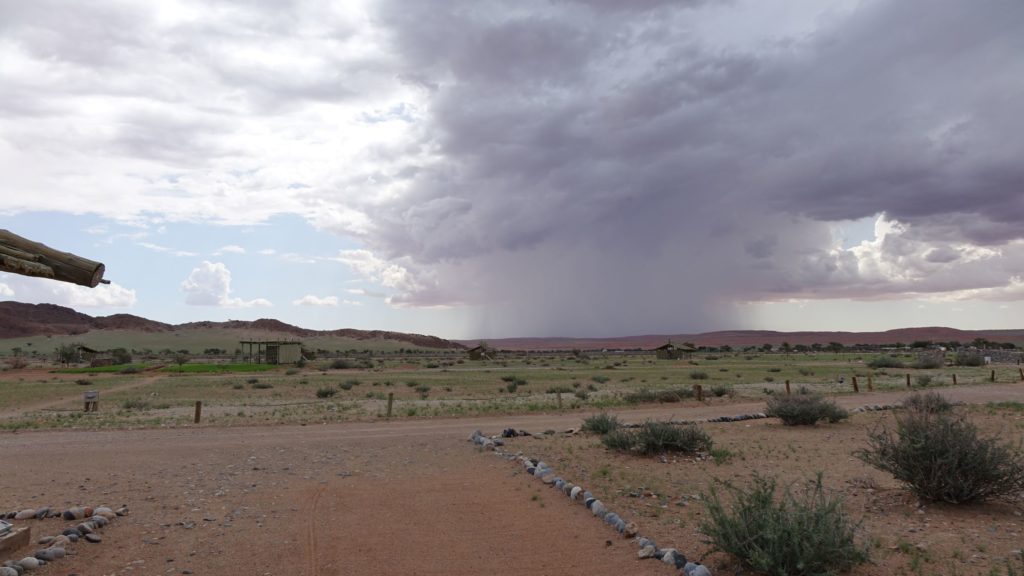
The wild animals seem to have disappeared completely.
We spend our first night in Namibia in a beautiful campsite along the Okavango River with a white sandy beach. Okavango! This name immediately reminds me of Nicolas Hulot’s shows. At the time, I devoured his shows, and they probably inoculated me with a desire to travel and discover. But it took a long incubation period for the disease to take hold.
Next day
We finish with a 90 km sand track, soaked by the previous day’s rain. The track is wide and straight. In dry weather it must be easy, we could negotiate it at over 100 km/h, but this is another matter. It will be a balancing act the whole way. To make things worse we meet a drunken guy in a white Golf I who keeps on passing us like a madman a few dozen centimetres away while sliding and finally comes back the wrong way. We end up at the end of the road, the bikes covered in mud, especially mine which can’t help but throw itself on the ground. We continue our straight line, to stop in Roy’s camp. Roy is no longer with us, but his spirit permeates the site which is decorated with unusual objects.

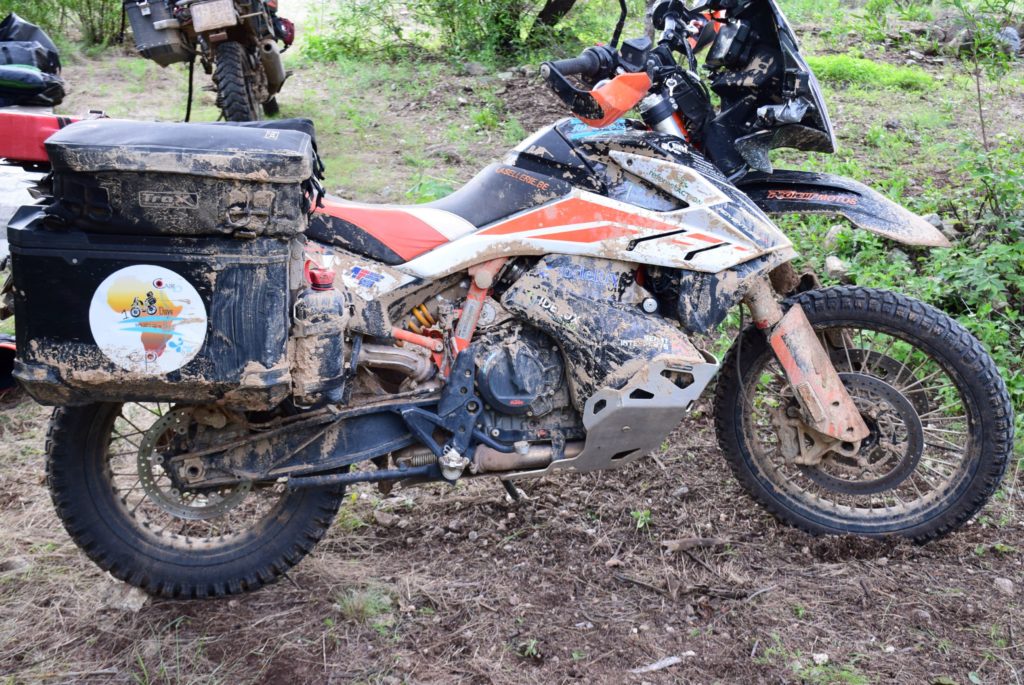
Next day
We reach the end of our straight line. At the end of the day we want to go to a campsite, but it turns out that the track to get there is sandy and muddy. We decide to go to the next campsite. This one shows “full booking”, so we think that there will be a place to set up our three small tents. We are greeted by Christie, a pretty woman in her fifties with a radiant smile. In fact, it is a birthday party and the site, which has just been taken over and renovated by Christie and her husband, will not be officially opened until March. However, we are welcome as the first campers. Christie and her husband are German nationals but were born in Namibia and are third generation expats in their family.
Next day
In the early afternoon we reach the desert, the vegetation becomes very sparse. After a 30 km track we arrive at the unique Spitzkoppe. Marble mountains stand in the desert. The campsites are several kilometres apart. We finally set up our tents on the so-called picnic area, because it is the only one with shade: when it is over 30° C in the shade, it is not possible to stay in the sun. At the end of the afternoon, we go for a tour of the site on our motorbike. As the weather is nice and we stay on the site, we replace the helmet by a cap and the motorbike jacket by a t-shirt. François and Victor even go so far as to wear shorts and flip-flops. As for me, I still prefer to wear my walking shoes,

Here we are on a visit taking pictures here and there, doing the mariol on the rocks. Meanwhile the sky is getting darker and darker. Well, as Victor often says, “it’s going to pass by”, it’s been like that for two days. So we continue our visit. Suddenly some big drops start to fall. We barely have time to get on our bikes when a torrent of water falls on us. In an instant we are plunged into an apocalyptic storm. We ride back to our tents, the downpour is so violent that without a helmet we can hardly keep our eyes open. Within 3 minutes, the track turns into a torrent of water and sand. Streams have formed in various places. We now have to cross several fords, which were completely dry 10 minutes ago. We finally reach our camp, we are soaked to the skin. The next day we learn that 45 mm of water has fallen, more than in the last six years.
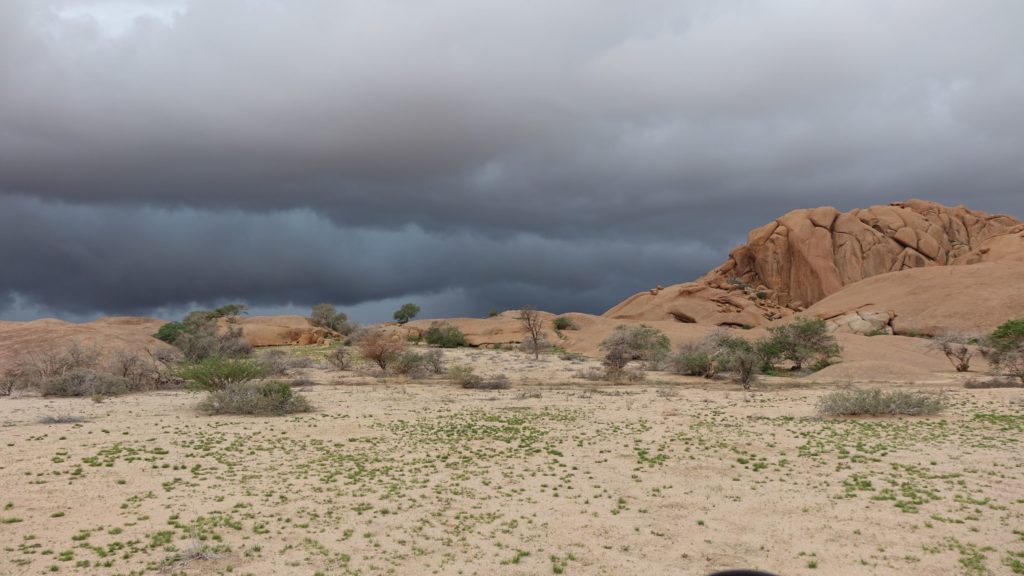
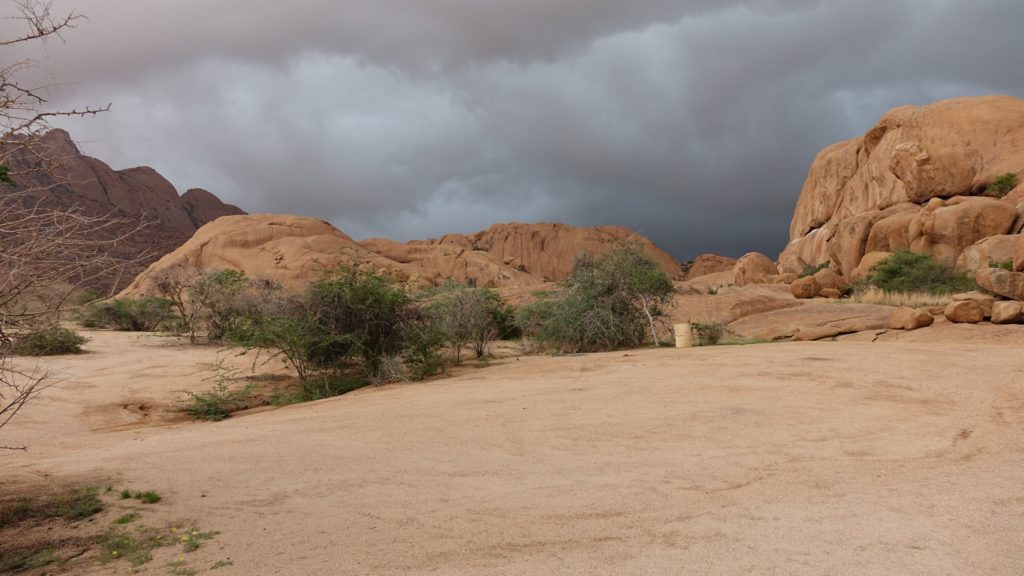

Obviously the inhabitants of the region are delighted with this rain which will finally fill the water table and the river which has been dry for 7 years. Not having been able to visit this sumptuous site entirely, we decide to stay one more day. The next evening a new storm flooded the area again. This time we got to safety in time.
The next morning, the weather was fine when we left the site. At the exit of the site we meet André the manager, we ask him about the state of the track following the storms. No problem to ride a motorbike, he says. We set off confidently. After 1 km we find ourselves in front of a river that did not exist two days ago. The river bed is between thirty and forty metres long, with water flowing over the last ten metres. A car is stuck in the part where the water flows. I take the first step. The first section of wet sand has a good bearing and is easy to negotiate. When I reach the last part, I enter the water, the bottom is filled with sand, not having gained enough speed I quickly find myself sanded in the middle of the water. Two people come to help me by shouting: “let’s go let’s go don’t stop”, this time I send all the sauce, the bike advances painfully to finally get out of the water and reach the bank. It’s Victor and François’s turn and they understand that they have to put the throttle to the limit. They also reach the bank. It is then that we become interested in the fate of the car. I realise that it is an Audi A6. How can you try to cross this thing with such a car? Only a 4×4 can cross. In the car there are two Chinese. We decide to give a hand to push the car. We only manage to push it back 2 metres. Finally André with his 4X4 pulls it out of the water. We continue on the track until we reach the road, without any problems.
Here we are on our way to the Atlantic coast. The desert is becoming more and more present. We arrive at the town of Schwartkopmunt. We set up our tents in a campsite located 50 meters from the ocean. Late afternoon we are on the Atlantic coast in a café restaurant with a magnificent 270° view on the ocean. There is a crazy crowd on the beach and in the café. We learn later that the river, which had been dry for 11 years, is flowing again after yesterday’s rain. People have come to see the mouth where the river meets the ocean.
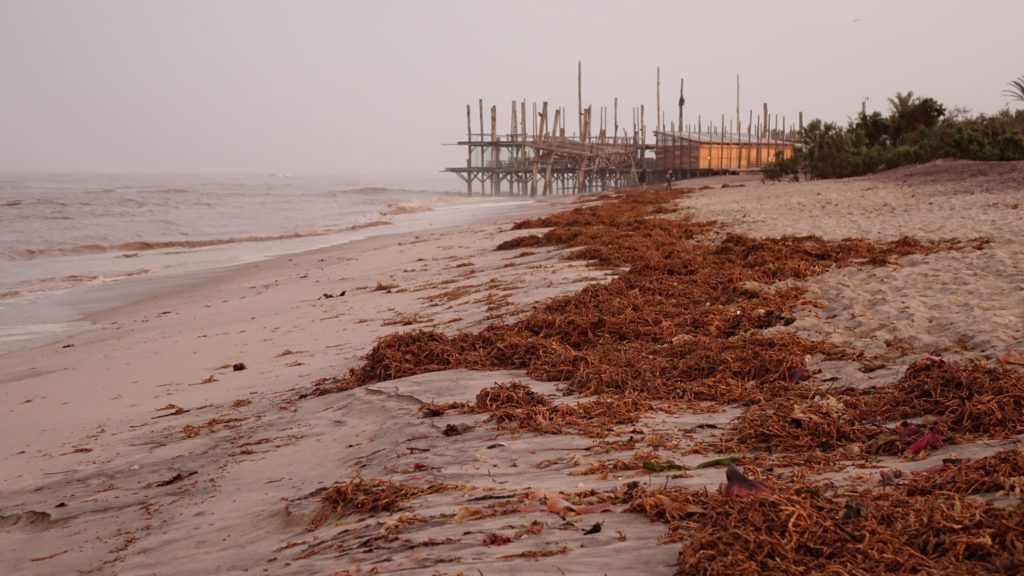
To sum up: 6 years without rain at the Spitzkoppe, 11 years without rain at Schwarktopmunt, we arrive and the water is flowing. When we tell you that we are riding for “Water for All”, we are not joking 😉. We could do without these rainy episodes, but people are so happy to have water again that we can only be happy for them.
We meet a Swiss couple from the Ticino region. They have been coming regularly to Africa for years and they know Namibia well. They advise us on some places not to be missed in Namibia like the “Solitaire” campsite. We decide to stay for two days.
The next day, I jump out of my tent at daybreak to go to the beach: I will not be disappointed by the sunrise behind the bridge. We go to visit the “Dune 7”. The road runs along the edge of the ocean, which gives us fresh air. We see a Cessna plane on the beach. We stop to chat with the pilot and the passengers. We say to ourselves “wow, great, here we can come to the beach by plane. The passengers tell us that the Cessna had an engine failure and the pilot had to make an emergency landing.

About twenty minutes later, we arrive at the Dune 7 site. We are unpleasantly surprised, nothing is maintained and there is a lot of waste lying around. The dune, however, is still there. I really want to go to the top. I start to climb it while François and Victor prepare their drone. It takes me ages to do the first 30 metres. The slope is very steep, with each step the sand slips away from my feet. Although I take long strides, with the slippage of the sand, I advance about 10 cm with each step. It’s 34°C, my shoes are sinking into the very hot sand, I feel like my feet are in an oven. I take a first break to catch my breath. I change my technique, I climb diagonally, taking the longest strides possible. Now I’m moving much faster. My thighs are starting to heat up! I take two more breaks before reaching the top. It’s windy at the top, it’s very pleasant and the view is worth the diversions. I realize that the slope on the other side is much gentler, the access by this side would have been easier. I take a few pictures and then go back down in less than a minute, doing Gazelle jumps in the sand that make me feel like flying.
The next day we leave the coast and drive to the “Solitaire” campsite. We cross the Namibe desert. Soon we find ourselves on a track. The atmosphere is special, all around us is the desert as far as the eye can see, the temperature on the dashboard is 34° and there is not a single square inch of shade. From time to time we are overtaken by a 4X4 or we cross one. We drive for several hours before finding some half alive trees on the side of the track. We take the opportunity to have a break and a bite to eat in the shade. We continue, the landscape changes, it becomes more rocky and hilly. In the distance we see an ostrich running at high speed. The track becomes more sandy and bumpy, we have to try to stay in a track created by a 4X4 where the gravel and sand have been swept away. At times it is not possible to avoid the sandier areas, so the front wheel slips and it feels like riding with a flat front tyre. Sometimes the bike starts to wobble quite a bit. In these moments you have to hold on to the throttle, ideally you should accelerate strongly. Accelerating when you lose control is a bit unnatural and it’s not easy to unlock your brain.


The landscape becomes mountainous and the track winding, it is a treat for the eyes. As we are in the rainy season, the desert is progressively covered with vegetation, it is extraordinary. We arrive at the Tropic of Capricorn. Of course we immortalize the moment. But we leave in a hurry because the storm is threatening us and big drops are starting to fall. We have the impression of playing cat and mouse with the storms. At times we get close to it, the temperature drops and the wind picks up, then again we move away from it, the wind disappears and the temperature rises quickly.
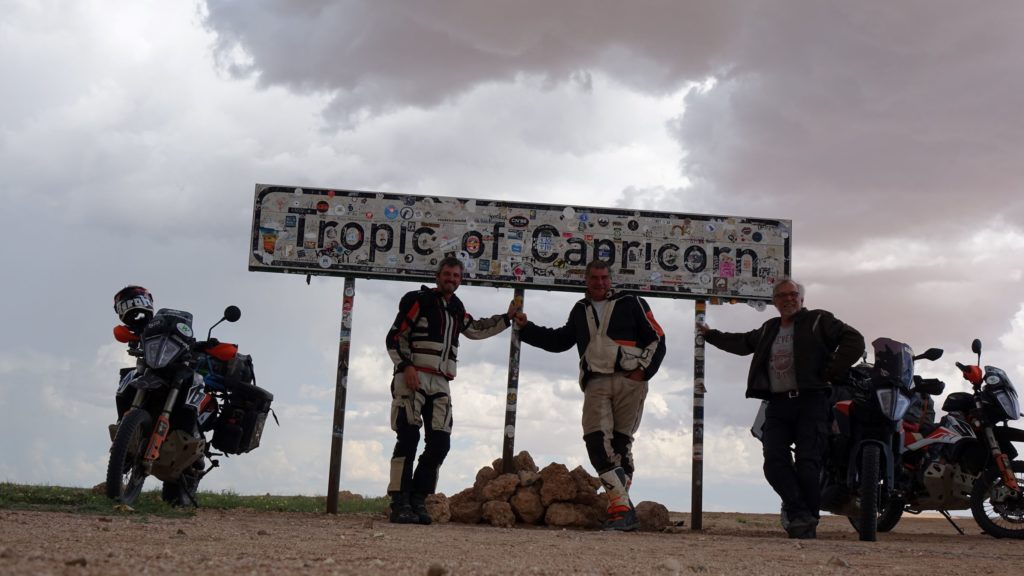
After 180 km of track, we reach “Solitaire”. The campsite is situated on a huge sandy plateau where small and beautiful white and blue flowers grow. The plateau is surrounded on the horizon by mountains with ochre reflections. The place is exceptional. After this day in the desert, we start with a cold beer. Then we quickly set up our camp because the storm is threatening us again. We only get a few drops this time. The sun sets in magnificent shades of fiery orange. Once again, it gives us a fabulous show.

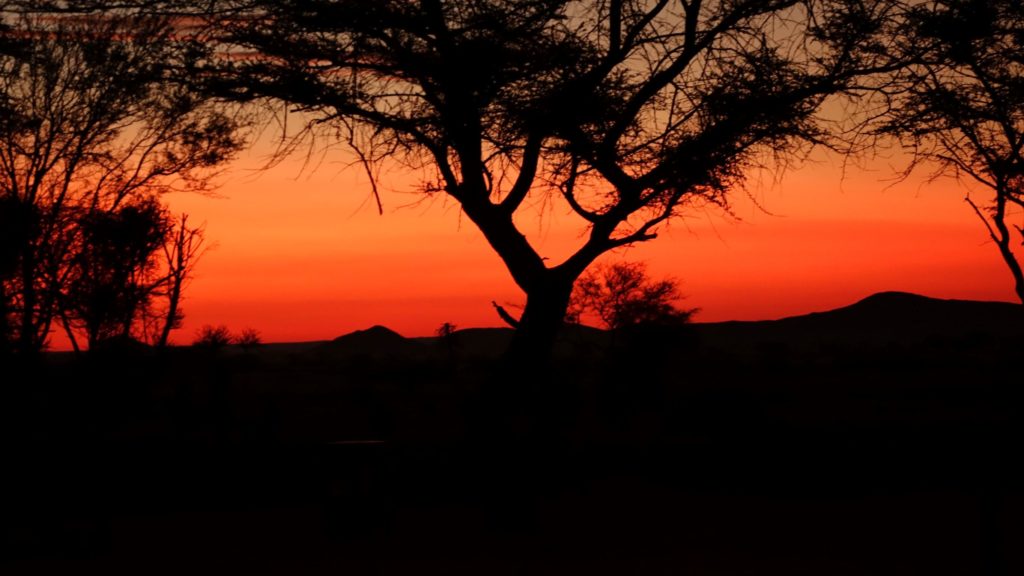
The next morning, despite having sponged myself in wine the day before, I wake up at dawn, just in time for the sunrise which offers me once again its grandiose spectacle. We were right to follow the advice of the Swiss couple we met two days earlier.
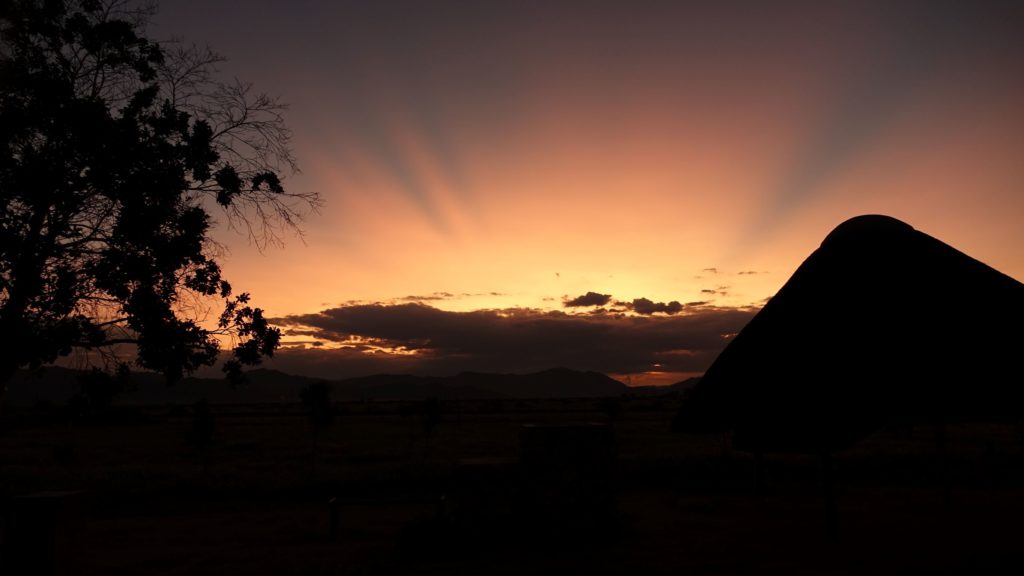
Today we are satisfied with a 40 km ride. The landscape is once again extraordinary. The track winds between the mountains and the fords which are dry. We stop at khhuhuhu’s where we drink refreshing home made sodas. We talk about life in the desert with our host. Nothing to do with our habits, for example: to go shopping for food, she goes to the nearest town, more than 200 km away, it takes her two whole days and she spends one night in a hotel. We are in another dimension.
The next morning, after an English breakfast and some food shopping, we leave this paradise to go deeper into the Namib Desert. 140 kilometres of track await us. Always breathtaking landscapes, one after the other. We arrive at our destination, right at the entrance of the park. We have a cold drink at the petrol pump next to the campsite. When we refuel our bikes to set up camp, the temperature on the dashboard is 44°C.
After the installation and the nap, Victor and François go to the entrance of the park to know the prices. We want to see the dunes, especially Dune 45 and Big Daddy Dune. The cut-off point is that motorbikes are not allowed to enter the park and this time there is no plan B for motorbikes. We discuss this with Max, the manager of the petrol pump and the campsite. He finds a solution to drive us there, we still have to negotiate the price. We know that the last 5 km to the Big Daddy Dune will cost us $180 Namibian, which is $540 Namibian for the three of us. We offer him $540 Nam for the 120km round trip, he replies with a deadpan look on his face “Ha you only want me to drop you off? Ok for 540 I’ll drop you off and come back. We burst out laughing at his words. We finally agree on 1000 $Nam. We make a deal and meet tomorrow morning at 6am. We go to bed around 9.30pm, it’s still 34°C, I’m dripping without moving on my mattress.
At 5am the mobile phone alarm clock goes off. The sun is not yet up and it is already 24°C. A shower followed by two coffees and some biscuits for breakfast. We leave to join our driver who is waiting for us. After brief introductions, we get into the Polo. The car enters the park as daylight is just breaking. We drive through the desert, on either side of the road glowing dunes, strips of greenery, and an azure sky. The contrast of these three colours with the particular light of the sunrise is extraordinary. Our driver tells us that it is exceptional to have greenery. Normally there is only sand, but the heavy rains of the last few days have changed that. The last recorded rainfall was in 2011.

With the fat grass, the animals come to feed, we immortalize some of them. We stop at Dune 45 to take some pictures. We continue to the end of the road, where we take the shuttle to Big Daddy Dune.
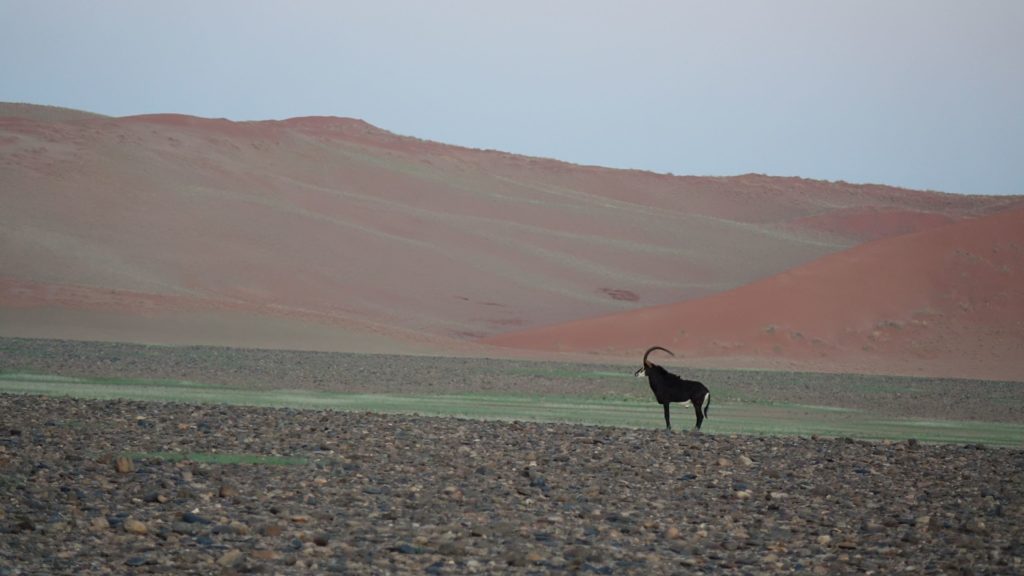
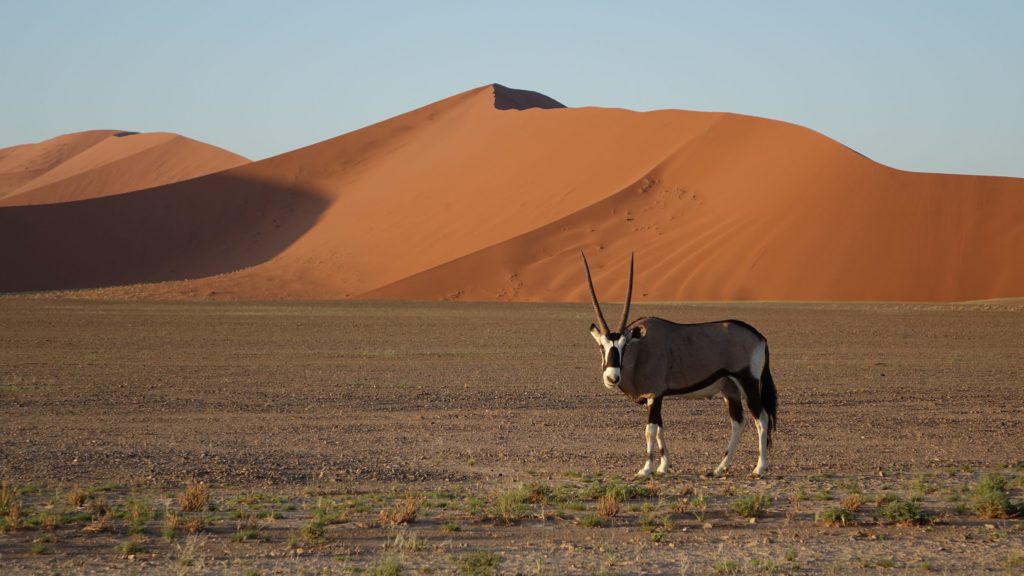

Indeed it is famous, nothing to do with the dune 7 climbed 5 days ago. 20 minutes of walking to get to the foot. I decide to try the climb, our driver shows us the way. We have to start with a perpendicular dune and then access the bigger one behind, staying on the ridge all the time. At first sight there is about 1 km to climb on the ridge before reaching the summit.

After about 45 minutes of walking, I take my first break. The sun is warming my face. I decide to follow the footprints that go down and then go straight up the face of the dune earlier than continuing on the ridge. This way I can walk in the shade. I think it will be better. I join the face of the big dune, I walk about 30 meters and I am already out of breath. I didn’t realise that the slope was so steep. I catch my breath and set off again. After ten metres I’m out of breath again. I think the tracks I’m following are those of someone who came down the dune. Now I am flanked in the middle of the slope. Turning around and going back up the ridge is taking too long. I look up, I still have a long way to go and the slope is dizzying. Giving up is not in my character, even if it’s in pain. I decide to carry on and do 8 or 10 more 25-step steps with 3 or 4 minutes of rest in between. Each time I’m out of breath and my pump is running at 180 beats per minute. Fortunately I have my camel bag, I filled it up this morning. So I started the climb with three litres of water. At this point I feel that it is already only half full. My legs are starting to give out on me and it’s getting harder and harder, and the slope is getting steeper. I decide to increase the length of my rest time between each effort so that my heartbeat is close to 100 beats before continuing. I am now forced to crawl, but in this position I manage to take 50 steps before I have to recover, which gives me hope that I will soon reach the ridge. Another 5 steps on all fours and I’m almost there. I still have 3 meters to go but I am still forced to stop and recover.
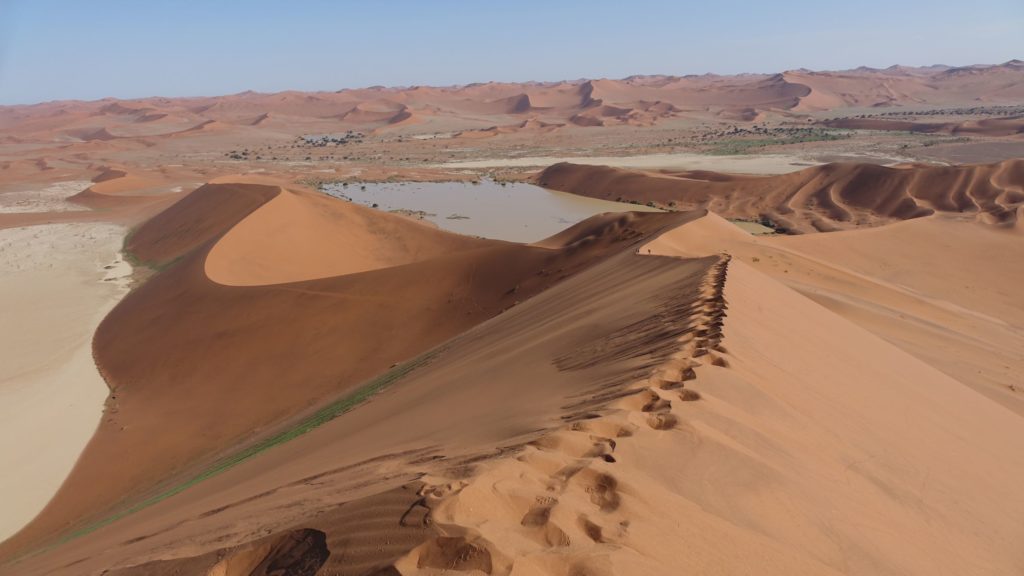
Here I am on the ridge, I can stand on my legs again. Only 80 metres to go and the summit will be reached. I left a lot of energy on this steep slope and my legs are wobbly. Two more stops are needed to reach the summit. I enjoy the incredible view over the desert. Of course, photos and selfies are part of the experience. I have enough time to recover before thinking of going back down. Just a detail, I don’t know which way is better to go. Two people are also approaching the summit, luckily one of them is a guide who has already made the climb several times. He starts by greeting me and says “you climbed the hardest face, frankly respect”. If I had known that before, I would never have set foot there. I answer him “yes, but it wasn’t a good idea, it was really difficult, but I got to the top, that’s the main thing”. I take the opportunity to ask him where the descent is. I take the opportunity to ask him where the descent is, “Straight down the steep slope, then you have to cross the dry lake and join the path to the car park”. I greet them and start the descent. This is the most fun part, in this steep slope and cushioned by the sand, I can easily do 3 meter long jumps. In less than 5 minutes I’m at the foot of the dune, 325 meters of vertical drop.

I will have to make a last effort of half an hour, under a heat that has become overwhelming, to cross the dry lake and reach the car park.

The next day we leave to reach the “Betta” campsite, 160 km of track. We still ride on the same type of track. And we continue to be amazed, at least when we can take our eyes off the track. When we arrive, there are some Africans (white people born in Africa) sitting on the terrace. The person in charge is a small Namibian woman, about sixty years old, her welcome is rather icy, well my goodness, it refreshes us, we are dying of heat 😉. There is a small shop which allows us to do the food shopping we need. Like every day, sunrise and sunset are great.
Next day
We head for the town of Betania. After 180 km of track, we stop at the city gate to regroup before entering the city. The tracks being very dusty, we leave a significant distance between us. François joins me, waiting for Victor’s arrival, I take the opportunity to satisfy a small natural need. I barely have time to finish when two police vehicles arrive at high speed with their lights on. I think to myself: “I’m not going to get a ticket for pissing in the middle of the desert”. A policeman gets out of one of the two vehicles and heads towards us. He takes out his mobile phone and asks us to take a picture of him. He poses Rambo style in front of the town sign. Then he takes a picture of the motorbikes, greets us and gets back into the vehicle which drives off again. We look at each other with François saying to ourselves that we will never be believed.
We stop at one of the oldest hotels in Namibia, opened in 1880. We settle in the campite area. At nightfall, when we reach our tents, we are invaded by hundreds of locusts. These insects are desert yellow in colour. They are on average 7 to 8 centimetres long, a real pleasure. We fight with the ones hanging on the door of the tent to get in without them getting in. As the weather is good and it is not supposed to rain we have only put up the inner part of our tents and not the outer one. So we are in a kind of mosquito net with the damn locusts on it. The sight is not very appealing.
Next day
We take the track again, it becomes faster. There are locusts all along the track. Our clothes and our bikes are quickly stained with locust juice. We try to avoid them as best we can, bugs of this size we see them coming. However, at best we can tilt our heads or lower our heads because there is no way we can change the trajectory of the bike and pass through the sandy strips, otherwise it’s a lambada. When a cricket crashes into our helmet while we are riding at 90 km/h, it’s a good slam.
We head for the “Roadhouse” campsite, another tip from Paul, François’ friend. This campsite is special, it is fitted out with a lot of old vehicles and we eat very well there. The only drawback: three wasps’ nests in the tree that was supposed to give us shade. I was attacked by a wasp a centimetre away from my eye. The result was intense pain in the eye, forehead and jaw, followed by 4 days with almost half of my face swollen. Victor was also attacked, three stings, wrist, skull and neck. I can’t remember ever seeing such aggressive insects. Afterwards, we kept a good distance from the tree. We stayed two days to visit the Fish River Canyon.

The next morning we headed for the border with the last country on this trip: South Africa.
Thanks for the link to this website, I wish you happy travels for the last week of your epic adventure – it has undoubtedly changed your view of life – be gentle with those at home who cannot comprehend what you have experienced and good fortune planning your next exploration : xx Laura @ Jack’s in Betty’s Bay
Hello Laura, we returned to Belgium last Friday. For the last three days, I have been fully aware of your advice.